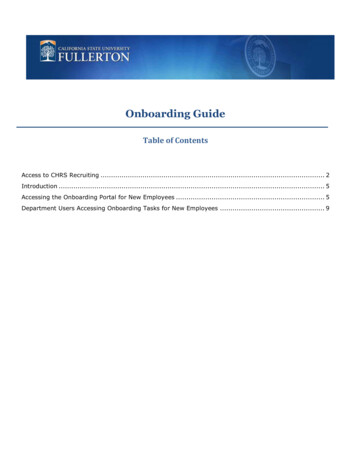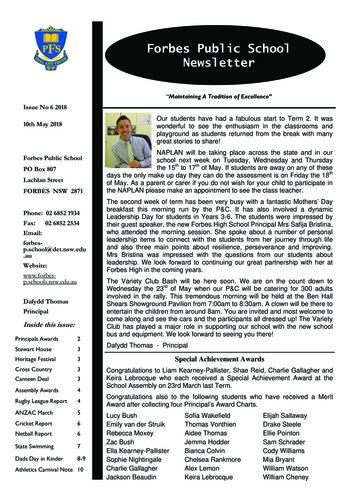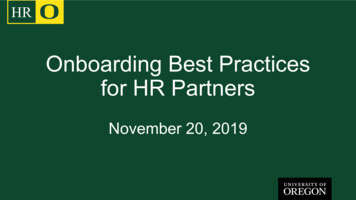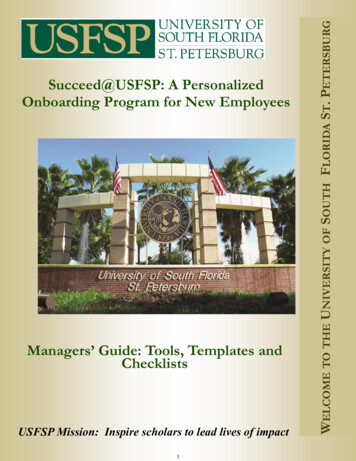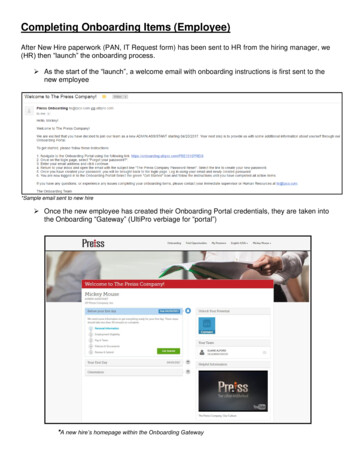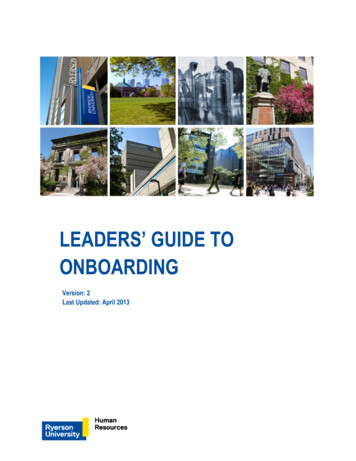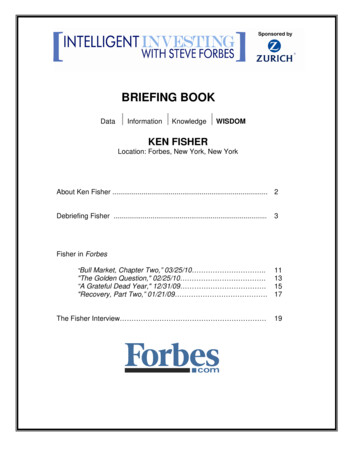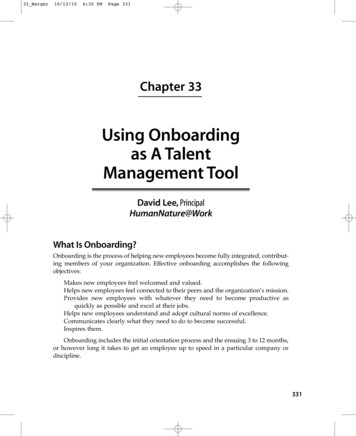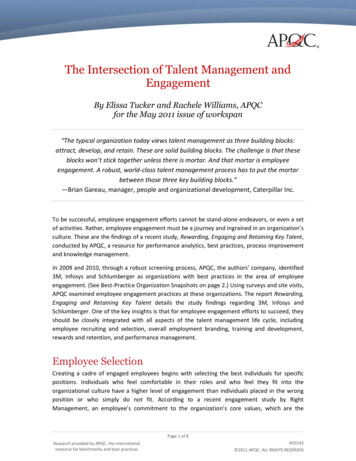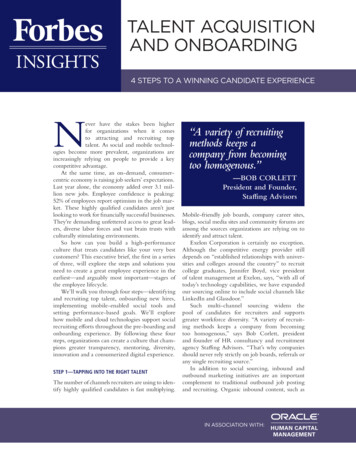
Transcription
TALENT ACQUISITIONAND ONBOARDING4 STEPS TO A WINNING CANDIDATE EXPERIENCENever have the stakes been higherfor organizations when it comesto attracting and recruiting toptalent. As social and mobile technologies become more prevalent, organizations areincreasingly relying on people to provide a keycompetitive advantage.At the same time, an on-demand, consumercentric economy is raising job seekers’ expectations.Last year alone, the economy added over 3.1 million new jobs. Employee confidence is peaking:52% of employees report optimism in the job market. These highly qualified candidates aren’t justlooking to work for financially successful businesses.They’re demanding unfettered access to great leaders, diverse labor forces and vast brain trusts withculturally stimulating environments.So how can you build a high-performanceculture that treats candidates like your very bestcustomers? This executive brief, the first in a seriesof three, will explore the steps and solutions youneed to create a great employee experience in theearliest—and arguably most important—stages ofthe employee lifecycle.We’ll walk you through four steps—identifyingand recruiting top talent, onboarding new hires,implementing mobile-enabled social tools andsetting performance-based goals. We’ll explorehow mobile and cloud technologies support socialrecruiting efforts throughout the pre-boarding andonboarding experience. By following these foursteps, organizations can create a culture that champions greater transparency, mentoring, diversity,innovation and a consumerized digital experience.STEP 1—TAPPING INTO THE RIGHT TALENTThe number of channels recruiters are using to identify highly qualified candidates is fast multiplying.“A variety of recruitingmethods keeps acompany from becomingtoo homogenous.”—BOB CORLETTPresident and Founder,Staffing AdvisorsMobile-friendly job boards, company career sites,blogs, social media sites and community forums areamong the sources organizations are relying on toidentify and attract talent.Exelon Corporation is certainly no exception.Although the competitive energy provider stilldepends on “established relationships with universities and colleges around the country” to recruitcollege graduates, Jennifer Boyd, vice presidentof talent management at Exelon, says, “with all oftoday’s technology capabilities, we have expandedour sourcing online to include social channels likeLinkedIn and Glassdoor.”Such multi-channel sourcing widens thepool of candidates for recruiters and supportsgreater workforce diversity. “A variety of recruiting methods keeps a company from becomingtoo homogenous,” says Bob Corlett, presidentand founder of HR consultancy and recruitmentagency Staffing Advisors. “That’s why companiesshould never rely strictly on job boards, referrals orany single recruiting source.”In addition to social sourcing, inbound andoutbound marketing initiatives are an importantcomplement to traditional outbound job postingand recruiting. Organic inbound content, such asIN ASSOCIATION WITH:
employee videos and blogs highlighting volunteer work and employee rewards, serve as powerfulendorsements of a company’s accomplishments andunique culture.Even more powerful than an employee videois an employee’s personal endorsement of a company’s brand. Strong relationships are critical tofinding quality talent as employee and social networking referrals develop into rich and reliablesources. However, nurturing employee and socialnetworking referrals takes commitment from theentire organization, from marketing to product development to sales. Each faction must workto extract the best talent from their individualnetworks.Fortunately, savvy organizations are supportingthese cross-enterprise efforts with social network–enabled intranet sites. Online capabilities featurejob postings, discussions, recommendations andreferrals, along with built-in application recruitment guidelines, referral links and organizationalbest practices.The advantages of employee referral programsare significant, according to Boyd. “We leverageour employees for sourcing and for getting referralsbecause our employees not only know what skill“The system that we’venow implemented has alot more transparency, aswell as mobility, so thatrecruiters and candidatescan access informationfrom their phones asthey’re moving around.”—AMY BESTSVP andChief Human Resources Officer,Exelon Corporation2 TALENT ACQUISITION AND ONBOARDINGsets we’re looking for but what kind of culture wehave. So they can help us pinpoint people who willbe a fit here.”Just as social network–enabled intranet siteshelp employees share potential candidates, socialcollaboration tools enable recruiters to share bestpractices and candidate knowledge. By supportingsocial and mobile collaboration among recruiters,these tools create a 360-degree view of candidates,from your desktop or mobile device, for real-timedecision making.For Exelon, social collaboration tools are particularly important. The company has morethan 30,000 employees and seven distinct business units. By relying on Oracle Human CapitalManagement, Exelon is able to share hiring bestpractices and processes across the entire organization for quick and consistent recruitment strategies.The value of social collaboration also extendsto the relationship between recruiters and potential hires. Open communication throughout therecruitment process is key to attracting top talent. Candidates appreciate being kept informed ofwhere they are in the application process, whetherit’s receiving an email notification that an application is processed or a text message that an interviewwill be arranged in the next three days.In fact, transparency throughout the interviewprocess is the cornerstone of creating a great candidate experience. By relying on mobile and socialtechnologies that allow candidates to be “part ofa conversation,” Joyce Westerdahl, executive vicepresident for human resources at Oracle, says organizations can significantly reduce “the frustrationfactor” so common in traditional hiring processes.With innovative recruiting solutions, Westerdahladds, “managers and recruiters can see where a candidate is in the application process so that there’sconstant communication with the candidate. Thathelps prevent any disconnect that can cause unnecessary churn or distractions for hiring managers andcandidates.”Amy Best, senior vice president and chiefhuman resources officer at Exelon, agrees. “Withour Oracle recruiting module, candidates are ableto track where they are in the application process. Until we transitioned to this tool, it was only
the line leader or the hiring manager who knewwhere a candidate was in the process. The candidate would have to follow up to see where theystood. The system that we’ve now implementedhas a lot more transparency, as well as mobility, sothat recruiters and candidates can access information from their phones as they’re moving around.”While the hiring process will always be “anadministrative process with lots of steps and workflows,” Boyd says mobile-enabled recruitingand social collaboration technologies are helping convert a traditionally opaque process into anexperience that displays “caring for a candidate.”After all, she says, the hiring process “is a candidate’s first real experience with Exelon. We want itto be positive.”“It’s really important fornew hires to feel goodwhen they land here. It’snot just about having anoffice and a place to sit,but feeling integrated andconnected to the peopleyou’re working with.”—JENNIFER BOYDVice President of TalentManagement,Exelon CorporationSTEP 2—HERE TO STAY: OPTIMIZING THEONBOARDING PROCESSNew hires are most likely to quit within the firstthree to six months of employment, according tothe workforce insights arm of credit-reportingagency Equifax. As a result, the onboarding stage isa small window of opportunity for an organizationto make a good impression. This holds especiallytrue for millennials, many of whom are just entering the workplace and trying to find the right fit.To stave off unnecessary churn, many organizations are making onboarding their top priority.According to a Brandon Hall Group study,1 for thenext 12 to 24 months, 52% of organizations areprioritizing optimizing their onboarding process,and 45% are prioritizing their onboarding technology solutions.While the goal of onboarding is to acclimatetalent quickly and reduce the time to productivity, this stage is increasingly being recognized forits power to create a positive candidate experienceand retain employees. That’s certainly been thecase for Exelon, which is currently streamlining itsonboarding process to enhance the positive effortsmade during the recruitment phase.“In a company such as ours—a Fortune 95 withseven different businesses—there’s a lot of diversity, so we want employees to have clarity aroundthe business: what Exelon means, what Exelonoffers and what our strategy is,” says Boyd. “Sowe’re working really hard to up our game in theonboarding space.”Efforts include hosting local orientation sessions, assigning new college hires a peer or“buddy,” and staging formal onboarding presentations on a monthly basis. “It’s really important fornew hires to feel good when they land here,” saysBoyd. “It’s not just about having an office and aplace to sit, but feeling integrated and connected tothe people you’re working with.”Technology also plays a key role in helpingExelon drive a positive onboarding experience.“We have a lot of information stored electronicallythat new hires can access either through our website or through the links we send to them,” saysBest.For instance, having a fully functioning workspace ready and waiting for a new hire canguarantee instant access to mission-critical HRassets, including: Online checklist of every internal site and systemneeded to learn how to become a high-performing employee. Customized checklist for onboarding tasks -in-talent-acquisition-technology/1COPYRIGHT 2016 FORBES INSIGHTS 3
the ability to review, update or trigger processcompletion status. In turn, this feature allowsHR managers to track training and policy compliance and report on those metrics. Work-/organization-/geography-related trainingdocuments and videos. Work files, documents and information frombackend systems to promote new hire productivity from day one. Communication channels with key HR, IT andpeer re-source contacts complete with built-insocial chats, discussion threads and conversationsfor immediate integration into the company. Training content from mobile, web and desktop,online and offline.Another effective onboarding tool is social collaboration technology. Social networking solutionsfacilitate real-time collaboration between individuals and teams, providing new hires with instantaccess to co-workers and mentors. For instance,at Oracle, Westerdahl says hiring managers utilize Oracle Social Network to help new employees“understand how Oracle operates, learn about thecompany, learn how things get done and to provide resources for any questions they might have.This online, self-service tool instantly connectsnew employees with other groups for support.”Because of its power to shape the candidateexperience, many organizations are now preboarding candidates to allow them to experiencea company’s culture before accepting a position.Arriving onsite to shadow employees, completing homework assignments that mirror workplacetasks and participating in trial programs wherecandidates do actual work onsite and receive payare all pre-boarding activities that help map the layof the land. That’s especially important in a market where 61% of employees still say job realitiesdiffer from expectations set during the interviewprocess.2“Onboarding starts from the minute a candidate is contacted,” says Westerdahl. “We setexpectations up front as best we can so that thereare no surprises when new hires begin work. Acandidate’s job responsibilities always match what’soutlined during the interview process.”2STEP 3—SUPPORTING A FLEXIBLE WORKFORCE WITHSOCIAL AND MOBILE IN A CLOUD ENVIRONMENTTo fuel employee collaboration and engagement,organizations are increasingly turning to socialcollaboration tools and employee engagement sites.The benefits of these powerful platforms are twofold, helping both employees and recruiters.For employees, social collaboration tools helpconnect remote and on-the-go workers whilemaking it easier for them to do their jobs and dothem well. That’s because social collaboration toolsand HR community sites are excellent at capturing the knowledge of experienced employeesand sharing this information across departmentsand functions. By leveraging social capabilities between teams and across the organization,employees receive the support they need to getwork done. At the same time, high-performingemployees can earn credit for their unique knowledge and contributions.For recruiters, harnessing the collective intelligence of employees via social collaboration ensuresnot only that new hires feel recognized for theirefforts, but that the company also benefits from asteady supply of rich ideas through employee collaboration. Instant knowledge sharing also enablesreal-time feedback for improved performance.Another key ingredient in building an engaged“From an HCMstandpoint, the cloudhelps you bring in peoplefaster, especially when youhave to hire 30,000 or40,000 people at once.”—JOYCE WESTERDAHLExecutive Vice Presidentfor Human nt-than-expected-glassdoor-survey/4 TALENT ACQUISITION AND ONBOARDING
and flexible workforce is mobile enablement.Mobile technologies allow employees to accessrecommended online training courses, knowledge-base answers and personal data, such as payand vacation time, anytime, anywhere. Thesetechnologies also make opportunities within theorganization more visible. By accessing information, such as upcoming job openings, employeescan chart their own career paths, whether applyingfor new positions or requesting job transfers.Although social collaboration and mobileenablement strategies serve varying purposes, theyshare a common engine: the cloud. Consider, forexample Exelon. “With our new cloud-basedrecruiting technology, we’re working on mobility and continuing to push the envelope aroundproviding broader accessibility to information,”says Boyd. “That’s the journey we’re on at themoment.”Because the cloud integrates data across multiple systems and sites, HR leaders can gain aholistic, 360-degree look at their candidate pool.Another key advantage: the ability to streamline“That’s one of thereasons we’re excitedto move to the cloudsolution. It providescandidates with moretransparency as to wherethey are in the hiringprocess, from screening tointerview to outcome.”—AMY BESTSVP andChief Human ResourcesOfficer,Exelon Corporationand accelerate recruiting and onboarding processes.“From an HCM standpoint, the cloud helpsyou bring in people faster, especially when youhave to hire 30,000 or 40,000 people at once,” saysWesterdahl, noting that Oracle hired more than22,000 employees last year, not including acquisitions. As a result, she says, “our mission is cloud.We have turned this big cruise ship, and we areheading to the cloud and transforming all aspectsof our business.”In fact, there are over 150 million employeesusing cloud-based HR solutions globally, according to estimates from HR analyst and principal ofBersin3 by Deloitte Josh Bersin. For these workers,the cloud empowers them to perform tasks, fromimporting a resume via LinkedIn or Facebook totracking an application’s status on a smartphone.“That’s one of the reasons we’re excited tomove to the cloud solution,” says Best. “It providescandidates with more transparency as to wherethey are in the hiring process, from screening tointerview to outcome. With the cloud, we’ll beable to provide candidates with visibility into thehiring process versus offering a black box.”In addition to supporting social and mobileinteractions, the cloud is a key contributor to apositive employee experience. Hiring, onboarding and training can feel “pretty administrative,”says Boyd. With a cloud-based HCM solution,organizations can create “a more consumer-gradeuser experience. Employees would rather feellike they’re interacting in a modern fashion that’sstreamlined and simple so that they can start talking to leaders and engaging with peers.”STEP 4—SETTING THE STAGE FOR GREATNESSInnovative tools for managing career goals can helpbuild a positive employee experience by teachingnew hires how to fast-track to success.So when should organizations begin sharingthese building blocks for great employee performance? It’s never too soon, according to Corlett ofStaffing Advisors. “Set performance expectationsbefore new employees even start work,” he says.“Defining outcomes is the linchpin of successfulperformance x3COPYRIGHT 2016 FORBES INSIGHTS 5
In the case of Exelon, Best says the company’srecruiters begin “explaining career paths” to candidates as early as the initial stages of the interviewprocess. “Because we are so diverse and have sevendifferent businesses, employees can have multiplecareer paths with our company,” she says. “So wemake sure to have discussions around performanceand career advancement early on.”Demonstrating clearly to candidates how theycan further their career offers a number of competitive advantages. First, it renders potential hiresmore likely to lean in and select an organizationas its first choice of employer. Greater transparency around goal setting and expectations alsogives candidates and new hires something toaspire to: attainable objectives that are rewardedcompetitively.There are several strategies for supporting goalmanagement. Regular, informal performancereviews can help employees recognize whatthey’re doing well and how they can achievehigher performance levels. Pulse surveys, conducted monthly, offer a real-time glimpse intohow employees feel about their actual performance. And data analytics, along withuser-friendly dashboards, are fast emerging asa tool that can be used for improving sourcing,recruiting and onboarding processes.In addition, social collaboration tools allowemployees to share project goals with other teammembers throughout an organization. Through asocial network collaboration platform, employeescan spark conversations about project milestones,and solicit ideas and information from colleaguesto share their strategies for success.RECOMMENDATIONSFinding and hiring quality talent has never beenmore critical or more challenging. Building awinning candidate experience can provide a keycompetitive advantage in a market where job seekers are calling the shots.However, treating candidates like your bestcustomers requires a balanced combination of6 TALENT ACQUISITION AND ONBOARDINGstrategy and technology. These strategies, whichare critical to creating a high-performance andcandidate-centric culture, include: Identifying and recruiting top talent Onboarding new hires Implementing mobile-enabled social tools Setting performance-based goalsThese innovative strategies, however, can onlybe successful if supported by the power of mobileand cloud technologies. From social networkingintranet sites to employee referral portals, thesetools give candidates greater transparency into hiring processes, providing new hires with instantaccess to corporate knowledge bases, and enablingrecruiters to identify and onboard top talent anytime, anywhere, from any device.As organizations become more comfortableleveraging social and mobile technology to attractand recruit talent, best practices are emerging.Lessons include: Create a multi-channel sourcing strategy thattaps a variety of channels, from LinkedIn toemployee referral portals, for talent. Empower new hires with self-service capabilitiesin the form of corporate intranet sites and socialcollaboration portals. Kickstart the onboarding experience by providing candidates with information on managingtheir career goals from the get-go. Create social networks that facilitate real-timecommunication among new hires, peers andmentoring groups. Support a flexible workforce with a cloud platform capable of providing 24/7 access to HRinformation, integrating data silos and deliveringa consumer-grade experience.By following these strategies, supported bysocial, mobile and cloud technologies, organizations can build a strong foundation for the nextstages in talent management: training and careerdevelopment of high-performing employees.
ABOUTFORBES INSIGHTSForbes Insights is the strategic research and thought leadership practice of Forbes Media, publisher of Forbes magazine and Forbes.com, whose combined media properties reach nearly 75 millionbusiness decision makers worldwide on a monthly basis. Taking advantage of a proprietary databaseof senior-level executives in the Forbes community, Forbes Insights conducts research on a host oftopics of interest to C-level executives, senior marketing professionals, small business owners andthose who aspire to positions of leadership, as well as providing deep insights into issues and trendssurrounding wealth creation and wealth management.FORBES INSIGHTSSALESBruce RogersChief Insights OfficerNorth AmericaBrian McLeod, Commercial Directorbmcleod@forbes.comErika MaguireDirector of ProgramsAndrea NishiProject ManagerSara ChinProject ManagerEDITORIALKasia Wandycz Moreno, DirectorMatthew Muszala, ManagerWilliam Thompson, ManagerEMEATibor Fuchsel, ManagerAPACSerene Lee, Executive DirectorHugo S. Moreno, DirectorCindy Waxer, Briefing AuthorCharles Brucaliere, DesignerRESEARCHRoss Gagnon, DirectorKimberly Kurata, Research Analyst499 Washington Blvd. Jersey City, NJ 07310 212.367.2662 www.forbes.com/forbesinsights
these tools create a 360-degree view of candidates, from your desktop or mobile device, for real-time decision making. For Exelon, social collaboration tools are par-ticularly important. The company has more than 30,000 employees and seven distinct busi-ness units. By relying on Oracle Human Capital Management, Exelon is able to share hiring best


